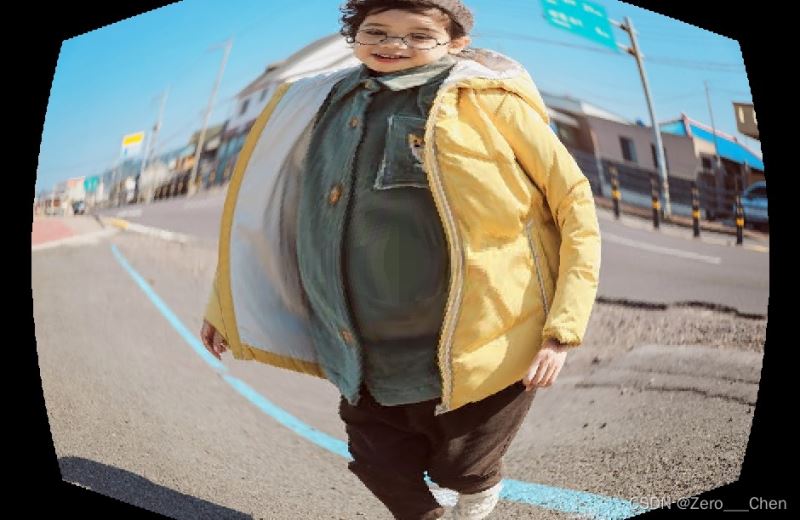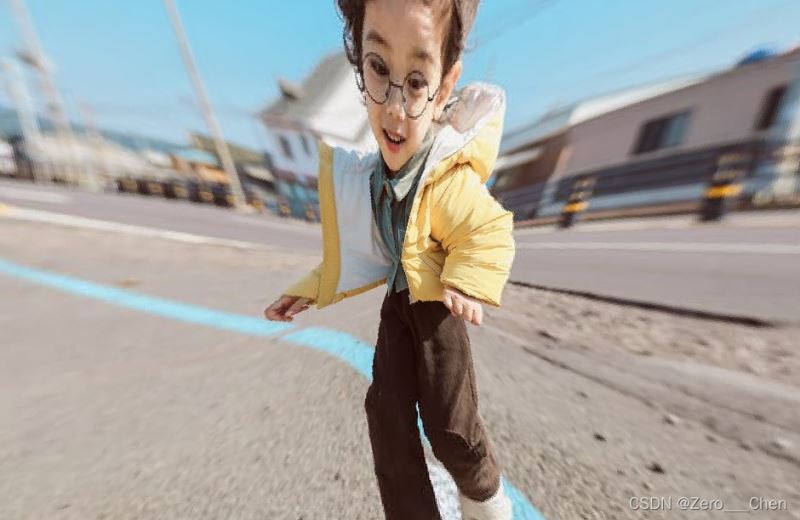您好,登錄后才能下訂單哦!
您好,登錄后才能下訂單哦!
這篇文章主要介紹了C++中怎么使用OpenCV制作哈哈鏡圖像效果的相關知識,內容詳細易懂,操作簡單快捷,具有一定借鑒價值,相信大家閱讀完這篇C++中怎么使用OpenCV制作哈哈鏡圖像效果文章都會有所收獲,下面我們一起來看看吧。

制作凸透鏡效果(將圖像放大)。根據網上查找的變換公式:
圖像放大:凸透鏡
x = (dx / 2)*(sqrt(pow(dx, 2) + pow(dy, 2)) / r) + cx;
y = (dy / 2)*(sqrt(pow(dx, 2) + pow(dy, 2)) / r) + cy;
請查看源碼注釋
bool Mirror_Magnify(Mat src)
{
/*
圖像放大:凸透鏡
x = (dx / 2)*(sqrt(pow(dx, 2) + pow(dy, 2)) / r) + cx;
y = (dy / 2)*(sqrt(pow(dx, 2) + pow(dy, 2)) / r) + cy;
*/
Mat canvas = Mat::zeros(src.size(), src.type()); //畫布,重新生成哈哈圖像
//圖像中心
int cx = src.cols / 2;
int cy = src.rows / 2;
//決定哈哈鏡大小
int radius = 200;
//圖像像素修改
for (int i = 0; i < src.rows; i++)
{
for (int j = 0; j < src.cols; j++)
{
//任意像素點到圖像中心距離
int dx = j - cx;
int dy = i - cy;
//重新映射像素點位置
int x = (dx / 2)*(sqrt(pow(dx, 2) + pow(dy, 2)) / radius) + cx;
int y = (dy / 2)*(sqrt(pow(dx, 2) + pow(dy, 2)) / radius) + cy;
for (int c = 0; c < 3; c++)
{
//防止越界
if ((x > 0 && x < src.cols) && (y > 0 && y < src.rows))
{
canvas.at<Vec3b>(i, j)[c] = src.at<Vec3b>(y, x)[c];
}
}
}
}
imshow("Mirror_Magnify", canvas);
return true;
}
制作凹透鏡效果(將圖像縮小)。根據網上查找的變換公式:
圖像縮小:凹透鏡
x = sqrt(sqrt(pow(dx, 2) + pow(dy, 2))) * compress * cos(atan2(dy, dx)) + cx;
y = sqrt(sqrt(pow(dx, 2) + pow(dy, 2))) * compress * sin(atan2(dy, dx)) + cy;
請查看源碼注釋
bool Mirror_Narrow(Mat src)
{
/*
圖像縮小:凹透鏡
x = sqrt(sqrt(pow(dx, 2) + pow(dy, 2))) * compress * cos(atan2(dy, dx)) + cx;
y = sqrt(sqrt(pow(dx, 2) + pow(dy, 2))) * compress * sin(atan2(dy, dx)) + cy;
*/
Mat canvas = Mat::zeros(src.size(), src.type());//畫布,重新生成哈哈圖像
int compress = 12; //壓縮強度
//圖像中心
int cx = src.cols / 2;
int cy = src.rows / 2;
//圖像像素修改
for (int i = 0; i < src.rows; i++)
{
for (int j = 0; j < src.cols; j++)
{
//任意像素點到圖像中心距離
int dx = j - cx;
int dy = i - cy;
//重新映射像素點位置
int x = sqrt(sqrt(pow(dx, 2) + pow(dy, 2))) * compress * cos(atan2(dy, dx)) + cx;
int y = sqrt(sqrt(pow(dx, 2) + pow(dy, 2))) * compress * sin(atan2(dy, dx)) + cy;
for (int c = 0; c < 3; c++)
{
//防止越界
if ((x > 0 && x < src.cols) && (y > 0 && y < src.rows))
{
canvas.at<Vec3b>(i, j)[c] = src.at<Vec3b>(y, x)[c];
}
}
}
}
imshow("Mirror_Narrow", canvas);
return true;
}
#include<iostream>
#include<opencv2/opencv.hpp>
using namespace std;
using namespace cv;
/*
哈哈鏡實現原理:讓圖像像素扭曲,將像素重新進行映射
假設輸入圖像寬w,高h。圖像中心點坐標(cx,cy),圖像任意像素點(x,y)到中心點距離 dx=(x-cx),dy=(y-cy),變換半徑r
*/
bool Mirror_Magnify(Mat src)
{
/*
圖像放大:凸透鏡
x = (dx / 2)*(sqrt(pow(dx, 2) + pow(dy, 2)) / r) + cx;
y = (dy / 2)*(sqrt(pow(dx, 2) + pow(dy, 2)) / r) + cy;
*/
Mat canvas = Mat::zeros(src.size(), src.type()); //畫布,重新生成哈哈圖像
//圖像中心
int cx = src.cols / 2;
int cy = src.rows / 2;
//決定哈哈鏡大小
int radius = 200;
//圖像像素修改
for (int i = 0; i < src.rows; i++)
{
for (int j = 0; j < src.cols; j++)
{
//任意像素點到圖像中心距離
int dx = j - cx;
int dy = i - cy;
//重新映射像素點位置
int x = (dx / 2)*(sqrt(pow(dx, 2) + pow(dy, 2)) / radius) + cx;
int y = (dy / 2)*(sqrt(pow(dx, 2) + pow(dy, 2)) / radius) + cy;
for (int c = 0; c < 3; c++)
{
//防止越界
if ((x > 0 && x < src.cols) && (y > 0 && y < src.rows))
{
canvas.at<Vec3b>(i, j)[c] = src.at<Vec3b>(y, x)[c];
}
}
}
}
imshow("Mirror_Magnify", canvas);
return true;
}
bool Mirror_Narrow(Mat src)
{
/*
圖像縮小:凹透鏡
x = sqrt(sqrt(pow(dx, 2) + pow(dy, 2))) * compress * cos(atan2(dy, dx)) + cx;
y = sqrt(sqrt(pow(dx, 2) + pow(dy, 2))) * compress * sin(atan2(dy, dx)) + cy;
*/
Mat canvas = Mat::zeros(src.size(), src.type());//畫布,重新生成哈哈圖像
int compress = 12; //壓縮強度
//圖像中心
int cx = src.cols / 2;
int cy = src.rows / 2;
//圖像像素修改
for (int i = 0; i < src.rows; i++)
{
for (int j = 0; j < src.cols; j++)
{
//任意像素點到圖像中心距離
int dx = j - cx;
int dy = i - cy;
//重新映射像素點位置
int x = sqrt(sqrt(pow(dx, 2) + pow(dy, 2))) * compress * cos(atan2(dy, dx)) + cx;
int y = sqrt(sqrt(pow(dx, 2) + pow(dy, 2))) * compress * sin(atan2(dy, dx)) + cy;
for (int c = 0; c < 3; c++)
{
//防止越界
if ((x > 0 && x < src.cols) && (y > 0 && y < src.rows))
{
canvas.at<Vec3b>(i, j)[c] = src.at<Vec3b>(y, x)[c];
}
}
}
}
imshow("Mirror_Narrow", canvas);
return true;
}
int main()
{
Mat src = imread("test.jpg");
if (src.empty())
{
cout << "No Image!" << endl;
system("pause");
return -1;
}
Mirror_Magnify(src);
Mirror_Narrow(src);
imshow("test", src);
waitKey(0);
system("pause");;
return 0;
}關于“C++中怎么使用OpenCV制作哈哈鏡圖像效果”這篇文章的內容就介紹到這里,感謝各位的閱讀!相信大家對“C++中怎么使用OpenCV制作哈哈鏡圖像效果”知識都有一定的了解,大家如果還想學習更多知識,歡迎關注億速云行業資訊頻道。
免責聲明:本站發布的內容(圖片、視頻和文字)以原創、轉載和分享為主,文章觀點不代表本網站立場,如果涉及侵權請聯系站長郵箱:is@yisu.com進行舉報,并提供相關證據,一經查實,將立刻刪除涉嫌侵權內容。